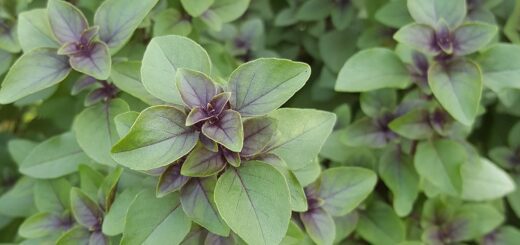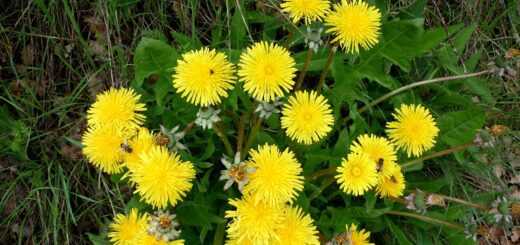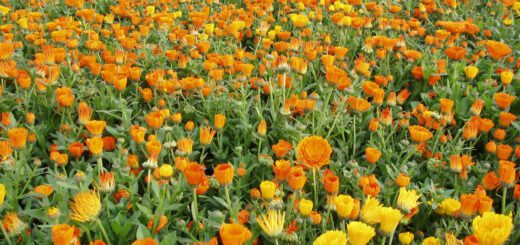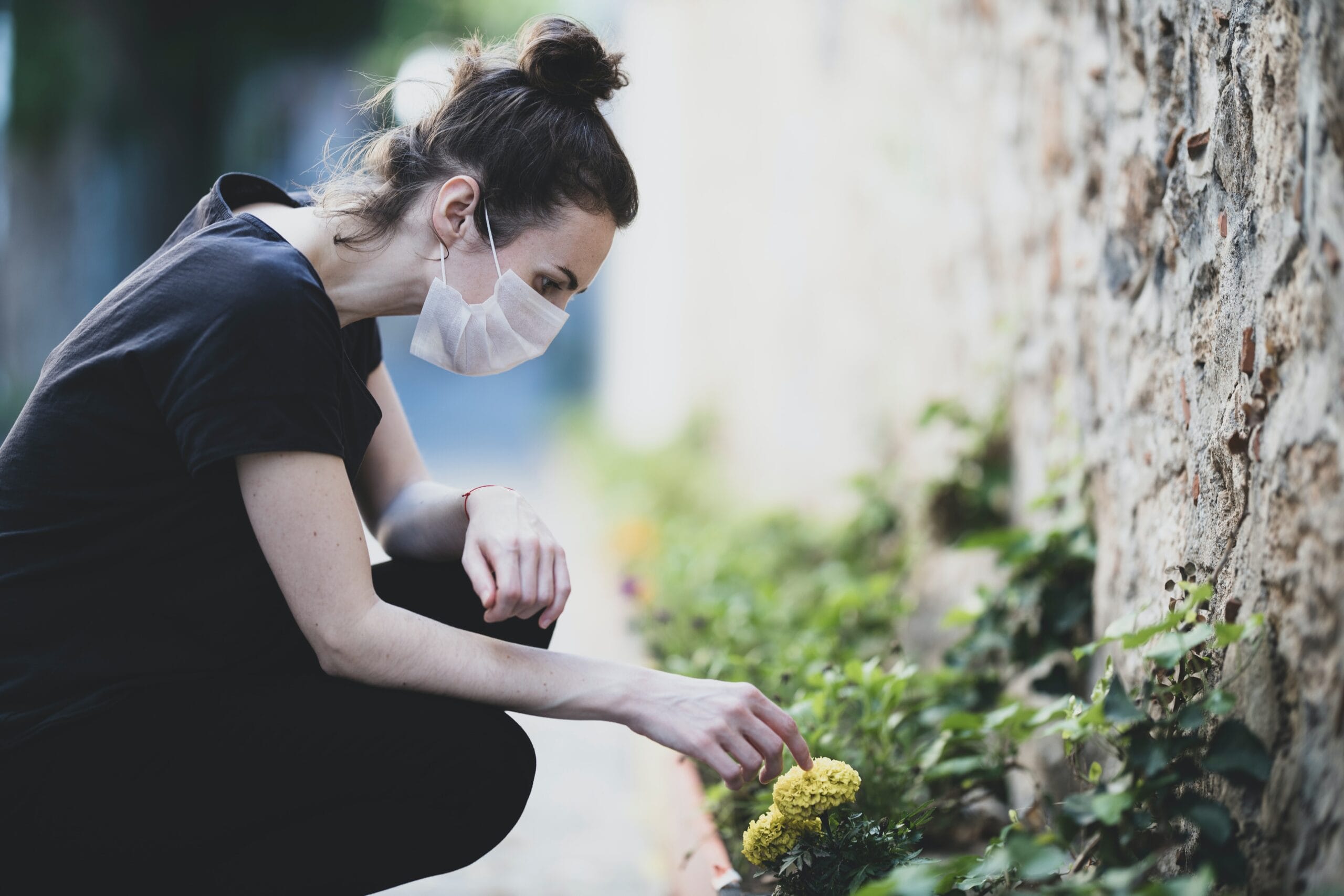Borage (aka Starflower)
Borago officinalis
Boraginaceae Family
I would like to present to you borage, a plant with many undeniably awe-inspiring historical associations and traditional uses, alongside numerous potential health benefits. I will present what has been demonstrated in the scientific literature, both in the garden and medicinally, laid out alongside traditional applications and indications. By the end of this article you should have enough good reason to plant, or to forage for some borage in your own garden or town, and together we can celebrate its multi-functional splendour and beauty.
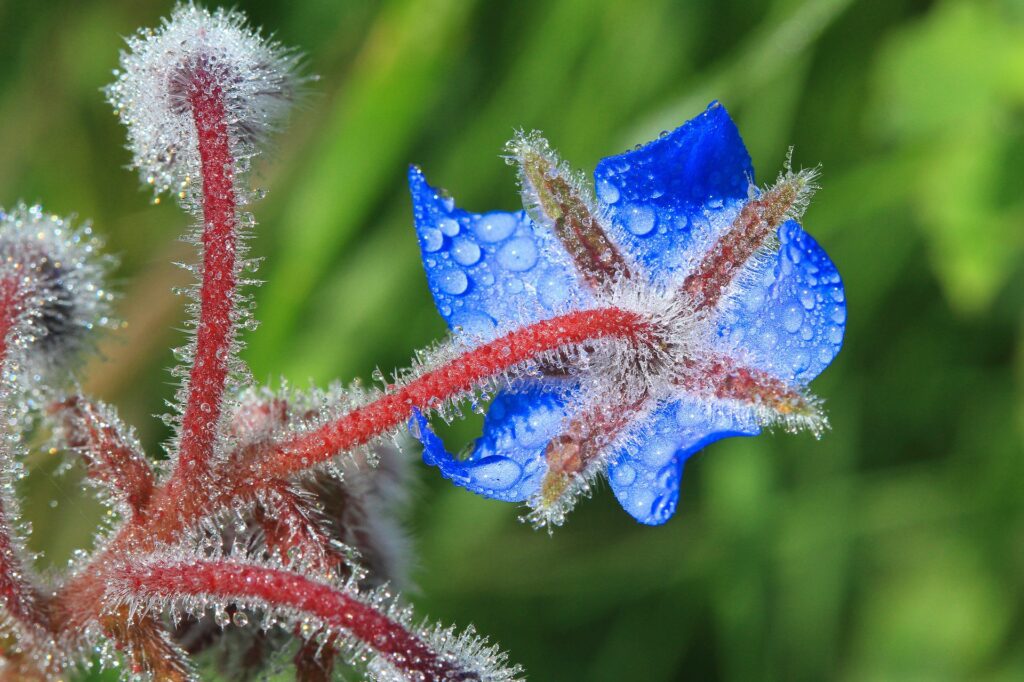
Borage in frost
Origins
Borage is said to have originated in the Middle East, and is thought to be a native annual in the Mediterranean region, however has since becoming naturalised throughout the majority of Europe, and North Africa, purportedly growing copiously and wild in wastelands of Britain. It is one of the most frequently consumed wild plants foods in many Italian communities, and is also consumed as a vegetable across different Spanish, Cretan and German regions. It blooms all year round in mild climates presenting its dainty yet electric five pointed blue or pink flowers. Being a close relative of comfrey may explain the leaves and stems being covered by fine hairs.
In the garden
Usually growing about 60cm tall and spreading across around 50cm wide, borage is self-seeding, and therefore it can be a good idea to let it colonise a whole patch of the garden. It likes full to partial sun and a well-drained soil. The seeds are best sown in spring through early summer, and directly inserted about 1cm into the soil after the last frost. Borage provides a hardy companion for strawberries, also has an affinity to grow alongside tomatoes, tansy, cabbage and cucumbers. It is not surprising that these companion crops improve not only yield, but also help to attracts bees. Borage has well established associations as being a bee attractor with alias names being Bee Bush and Bee Bread.
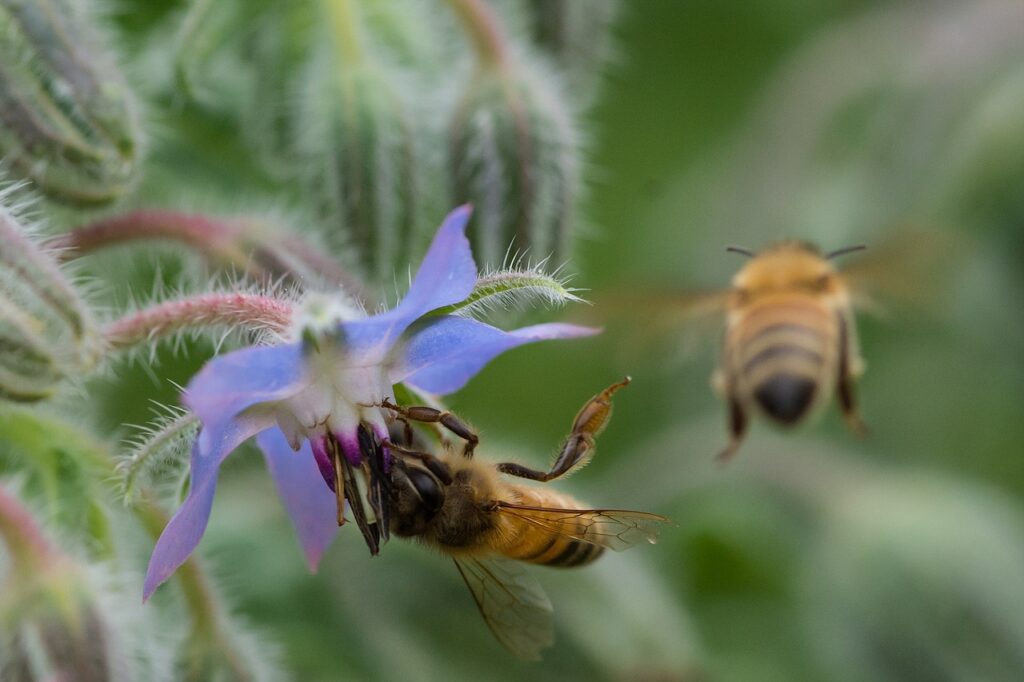
Bees LOVE borage!
Ancient uses
Since ancient times borage has been associated with courage, gladness and forgetfulness. Its name is thought to derive from the Gaelic word borrach, meaning ‘a person of courage’. Others have claimed it originates from the Latin, Italian or French words meaning wool or hair. An additional Latin etymological idea connects the name with the phrase ‘I bring the heart’, given the beneficial effects associated with the emotions. The Welsh name for Borage is Llawenlys, meaning herb of gladness. Diascorides and Pliny, our ancient Druid contemporaries wrote of borage’s ability to provide heart comfort, and ‘purge melancholie’. They also believed it to be the famous Nepenthe of Homer, the herbal elixir delivering ease from grief and banishment of mental sorrow. Since then, borage has been used by many-a herbalist to lift spirits, promoting good cheer. Steeped in wine, it was said to bring about complete forgetfulness while inducing, slight sedation, relaxation and reduction of worries and everyday concerns. However, regardless of the role and capabilities that wine alone could play in achieving these objectives, this preparation was attributed to borage’s association with courage. And rightly, historians across time have claimed that the ancient Celts steeped borage in wine to bring about courage, and come the time of the Crusades, tradition had established that borage should be attached to the stirrup cups of departing knights. Old wives tales report of women slipping the leaves or flowers into the drink of their chosen man to divine a marriage proposal (additional courage sparked from the alcohol probably worked synergistically producing this desired effect).
In the medicine chest
The dried leaves are the plant part used medicinally, which are indicated to provide soothing as a respiratory herb, attributable to the mucilage (a gelatenous substance) it contains. It is recommended as cold or flu preparation, especially where there is lung involvement, offering other various actions that may be of benefit, including working as a diaphoretic (sweat-inducing and fever breaking particularly as a hot infusion), expectorant or cough remedy (helping a person to cough up mucous), and as an anti-inflammatory. Coined a ‘tonic’ in the traditional literature, borage may also aid in convalescence following a cold or flu.
Another traditional use of borage was as an agent to induce diuresis, employed to help expel toxins from the body. Borage has also been associated with laxative and lenitive (stool softening) effects. From these effects perhaps borage gained its symbolic associations with helping to let go.
Borage also exerts activity on our endocrine systems, which is in part attributable to its steroidal saponins. The chief hormonal affinity appears to be with the adrenals, with borage able to tonify, restore and improve their function, helping to aid against chronic stress on the body and rebuild from complete exhaustion by restoration of the adrenal cortex. Borage is especially useful post-treatment with corticosteroids like cortisone and steroids, and is best used in this manner as a tonic aiming to rebuild and restore the adrenals over a period of time. Another hormone effecting activity associated with borage is galactagogue (milk-producing) for nursing mothers, and the plant has also been used traditionally in female reproductive issues including many of those associated with PMS or peri-menopause.
Nutritive anti-inflammatory wonder-gem-of-a plant
Borage leaves contains tannins, essential oils, potassium, calcium, a host of other trace minerals, and vitamin C. Also, the seeds contain high amounts of gamma-linoleic acid (GLA), a polyunsaturated fatty acid, with levels even higher than in Evening Primrose oil, for which GLA as a nutritive compound is perhaps best known. GLA converts to linoleic acid in the body, where it is further synthesised into prostaglandin E1 (PGE1). PGE1 is a potent anti-inflammatory agent known to protect the heart and vascular system by acting as a vasodilator, thereby lowering blood pressure, reducing blood-clotting, and lessening stroke risk. It also aids weight loss by increasing metabolism and the rate at which fat burns. Further, PGE1 has been shown to play a huge role in supporting proper immune system function by activating T-cells, while also inhibiting cell proliferation including malignant and mutated cellular development and growth. Further DNA protection and anti-carcinogenesis is granted by other constituents of borage including rosmarinic acid and a mixture of phenolic compounds, which possess antioxidant and free-radical scavenging abilities. Recent animal studies have additionally revealed nootropic, or cognition and memory enhancing activity of borage, which may be attributed to the presence of these antioxidants.Thereby constituents from borage have been demonstrated to act as both preventative and protective agents against cancer cell development and proliferation, destroying these and other unwanted body substances, reversing cancer cell growth, and also aiding in convalescene post illness.
While PGE1 synthesis is often compromised by medications taken for inflammatory conditions including arthritis, eczema and auto-immune conditions, the GLA contained in the likes of borage seeds however, help to reduce pain and inflammation by regulating the release of the stored inflammatory compound arachidonic acid. Indeed, up to 64 per cent reductions in pain symptoms were demonstrated in a randomised control trial of people with rheumatoid arthritis taking 2.8gram/day doses of the seed oil. Borage seed oil can also be applied topically to treat swelling and inflammation associated with arthritis, which is attributable to the GLA. There has also been promise shown in topical application for atopic dermatitis.
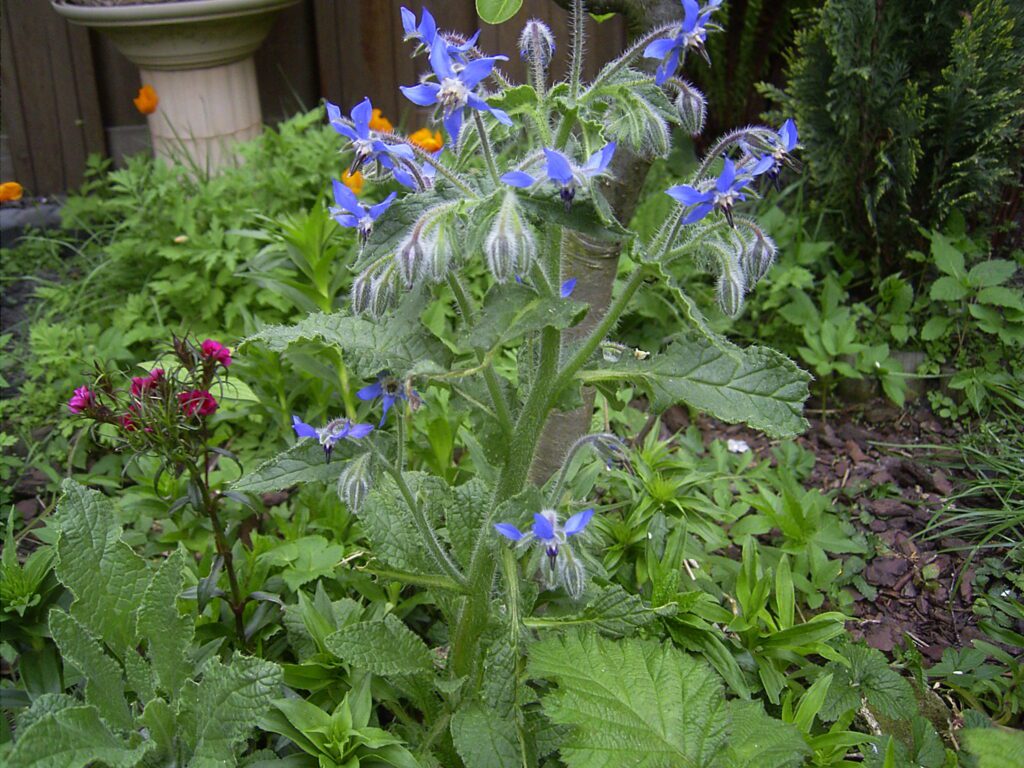
Harvest
The dry unblemished leaves may be harvested when the flowers come into bloom early summer. The seeds turn black as soon as they ripen immediately falling to the ground. Therefore specific tricks should be applied for effective harvest. Other than collecting a few seeds each days as they ripen, another method could include attaching muslin or another natural easy breathing cloth around the base of the stem in such a way to catch the seeds at their decent. Otherwise cut the stem prior to the seeds ripening and hang them in a cool, dry, well ventilated space.
In the kitchen and preparations
The young leaves possess a crisp cool taste reminiscent of cucumbers. They can be infused in oil, pickled, added to soups, or fried up as fritters, and will make a delicious addition to salads, including fruit salads. The flowers too provide that cucumber fresh taste, with an enchanting dash of colour to brighten up any dish. The leaves and flowers may also be infused in wine, as in days of yore.
The tannins, saponins, and essential oils from the fresh juice of this plant also make it an effective tonifying and cleansing agent for the skin, which not only cleanses, tightens, refines and cools, but is also claimed to narrow the capillaries, thereby reducing redness.
Dosage
Try borage as a tea, with one cup of boiling water per two teaspoons of dried herb infused for 10 to 15 minutes. Enjoy up to three times per day.
Words of caution
Borage should be avoided during pregnancy, because is associated with an increased miscarriage risk. Therapeutic doses of the borage seed oil should be avoided as a long term treatment, especially in those with compromised liver function due to possible accumulation of the plants alkaloids and subsequent damage to the liver.
A warning should also be heeded in those on blood thinning medications due to increased bleeding risk. Discuss any concerns with your healthcare practitioner.
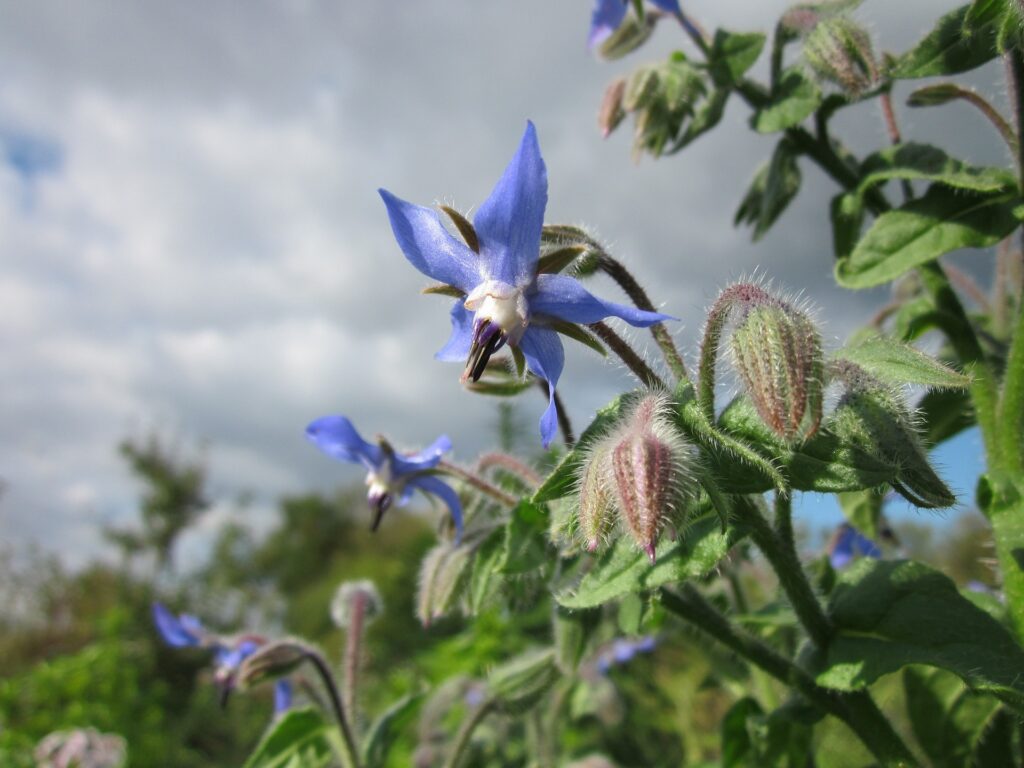
Some herb for thought
There are measures that we must all take to reduce our daily stress and enhance our capacity for longevity. Steps may be lifestyle related such as meditation, yoga, gardening, or simply being in nature; diet associated, including eating mostly a whole foods and plant-based diet; or numerous other self-nurturing methods (maybe applying a fresh borage toner?!). By taking time to attend to our needs on each physical, emotional and spiritual level, we are more likely to have greater courage and better opportunities to fulfill our life purposes, while focusing on larger goals and virtues: love, connection, compassion, peace, creativity… (please fill in your own), or other wisdoms that lead us towards self-growth.
Borage may ask us to think about what courage means to us. Courage may be perceived simply as an act, such as summoning a courageous attitude and standing up for justice; or it may stem from a deeper inner strength and the braveness of having an open, kind and generous heart. Courage may require us to look beyond our own needs to the needs and situations of others, and to try to perceive in them the greater good. Sometimes forgetfulness may be required for courage to come forth, and at times conscious committed acts of relinquishing memories, thoughts and other brandings that prevent seeing the golden lining. Remembering that while cautiousness can arise from fears and cowardice, it also comes from wisdom that helps us to avoid being impulsive in our decisions and actions. At first glance our actions may appear brave, however on closer inspection they could be founded on bravado. Perhaps taking mindful meditation time in the garden can help to illuminate the difference between the two.
Ultimately, an open-hearted strength and ability to let bygones be so might restore our confidence and faith in human nature, bringing with it a joyful lightness and happiness, such as those feelings and qualities that borage has been thought to deliver. It leaves me with no advice other than to see to some planting, foraging or a little wine time with borage, so much as the need for easing up, letting go, and joyful heart-building invocations render it indicated. Cool as bunches of borage!
May the open-hearted courage of borage be with you. 🙂


